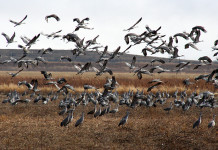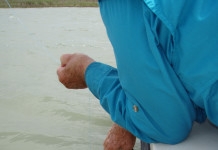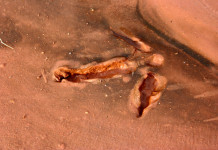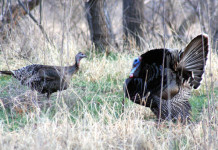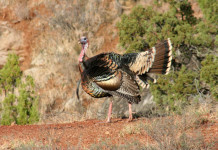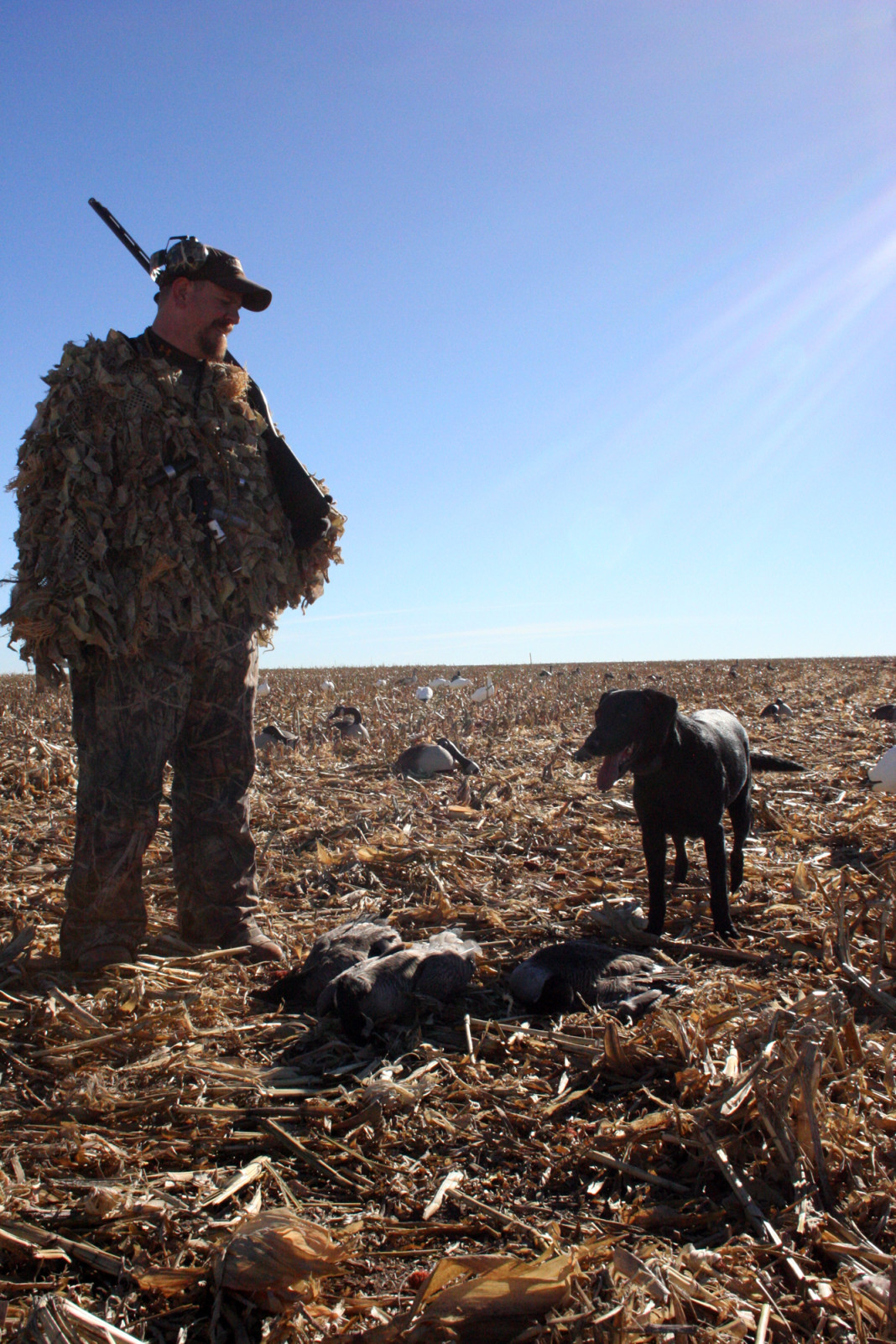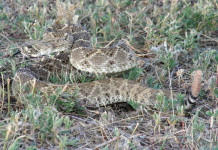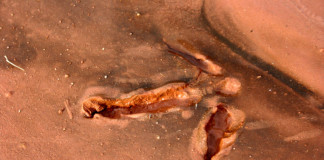Goose hunting in Texas has a long and storied history, but in recent seasons the Lone Star State has seen a huge decline in bird and hunter numbers, something that has biologists and wildlife officials seeking answers.
Chief among them is where all the birds have gone, and when – if ever – they might return. There’s no doubt that geese hunted from one end of the continent to the other get smarter along the way, but the migration patterns also are shifting, with traditional hot spots including the rice country along our coastal prairies and the southern Rolling Plains getting fewer flights of birds.
There’s no doubt that drought conditions have wreaked havoc on goose endeavors by outfitters across the state, and amid more dry times this year, the overall forecast for waterfowl hunting isn’t as great as it could be. That being said, there will be no shortage of waterfowl, according to U.S. Fish and Wildlife Service estimates. This year’s waterfowl surveys show that superb conditions in the Prairie Pothole Region again made the region a duck factory, helping to produce an overall estimate of 49.2 million birds, which is an 8 percent increase over last year’s figure of 45.6 million. This year’s figure also is 43 percent above the long-term average. There should be an abundance of a number of sought-after species, including mallards, which were estimated at a count of 10.9 million, a rise from 10.4 million the previous year.
The blue-winged teal estimate also was off the charts at an estimated 8.5 million, up from 7.7 million in 2010, and 75 percent above the long-term average. Similarly, the green-winged teal estimate of 3.4 million is above last year’s count of 3.1 million and 69 percent above the long-term average. You may not see many teal during the late season, but if you do, they’ll be in big flocks, which doesn’t mean they’re any easier to hit.
Typically, the conditions that bode well for duck production also aid goose production, especially in years when the northern United States receive adequate to above average moisture. However, geese simply continue to move out of areas they previously frequented, especially in some of what used to be the best hunting areas in the country.
Kevin Kraai, waterfowl program leader for the Texas Parks and Wildlife Department, said that the face of Texas goose hunting is drastically changing across the state.
“Our mid-winter surveys have shown significant declines in recent years related to loss of rice acres and drought,” Kraai said. “Unfortunately there is little relief in sight with the continued water restrictions for rice farming. We at TPWD are partnering with DU (Ducks Unlimited) and private landowners to aggressively put more habitat and water on the landscape the next few years in hopes of reversing this trend.”
Kraai noted that light geese continue to shift their flight paths across Texas, something that isn’t good at all for hunters along established corridors.
“Snow geese are very adaptive and are settling in new areas further inland in the Central Flyway and in the Mississippi Alluvial Valley where corn and rice acres continue to increase and little hunting pressure currently exists,” Kraai said. “Additionally, we are seeing increasing numbers of light geese further inland in Texas along the Trinity, Sulphur and Brazos river valleys. There also appears to be a growing population of white-fronted geese southwest of San Antonio in the agricultural areas of Uvalde, Medina and Frio counties, which is good considering the very low numbers of white fronts visiting the Gulf Coast these days.”
While some locales in North Texas and the eastern Rolling Plains historically have had solid numbers of birds, the goose hunting in places such as Knox and Haskell counties, north of Abilene, have seen better times, which honestly is too bad for some of the best hunting country in the state.
“The drought coupled with a dropping water table has crippled the goose hunting opportunity in this area,” Kraai said. “In recent years there has been very little surface water for roosting and the main attraction of peanut fields that are highly dependent on ground water irrigation, are becoming very scarce as well. This area has held as much as 200,000 geese and was arguably the best small Canada goose hunting in the country. Recent inventories during our mid-winter waterfowl survey have resulted in counts below 5,000 total geese. Many of the outfitters in this area have either moved or gone out of business.”
Like the Rolling Plains, the area farther to north has undergone a transition period when it comes to goose hunting, which has meant a shift in tactics.
“The Texas Panhandle remains a great destination for goose hunting but it too is going through its own challenges and changes,” Kraai said. “Natural surface water associated with playa wetlands has essentially been nonexistent the last few years, and the birds have learned to adapt by utilizing more permanent water associated with feedlots, beef packing plants and even the urban lakes and effluent ponds throughout the Panhandle. Goose numbers, especially small Canada geese, remain strong and those hunters that have learned to hunt near city limits have been very successful.”
Kraai noted that the late conservation order season for light geese, featuring more liberal bag limits and hunting methods, isn’t being used as much as it previously was – for obvious reasons.
“Declining numbers of snow geese coming to Texas, early springs and an aging, well-educated population has resulted in very low participation in the conservation order in Texas,” he said. “We have gone from an all-time high participation of near 28,000 conservation order hunters in 1999 to a little more than 1,000 hunters this past year.”
Michael Rezsutek, a Texas Parks and Wildlife Department biologist for the upper coast, said that goose numbers and locales they previously frequented have continued to confound biologists for a variety of reasons.
“The distribution of geese in Texas is in a state of flux right now,” Rezsutek said. “The recent drought, changes in habitat conditions to the north, changes in agricultural practices and in land use within the coastal prairies are all working to change the way geese make use of these areas.”
When it comes to typical haunts, it’s the same story across the top portion of the Texas coast.
“On the upper coast I haven’t seen any new hot spots developing,” Rezsutek said. “Geese have been using the same areas for the past 15 years or more. It’s more a matter of fewer geese using those spots compared to the numbers seen in years past. Some areas in the central coast that were once heavily used by geese have become suburban areas, so we’ve lost some wintering habitat that way. They seem to be using the remaining areas when conditions are favorable, but because of drought the central coast has had significantly fewer geese spending the winter there than in past years.”
While the Texas wintering goose figure has dwindled from what once was an impressive bevy of birds, the overall number of geese actually is holding strong.
“Continentally, the goose population is still high and climbing,” Rezsutek said. “We’re just not seeing as many in Texas in the winter as we used to. The reasons seem to be more grain production combined with milder winters and less hunting pressure in states to our north. Any change in the trend in goose numbers in Texas over the short term are not likely. For the numbers to climb again we would need to see conditions to the north become less favorable so that geese would come down to the coast, and at the same time conditions here become more favorable.”
Rezsutek said that staying mobile is key, which should come as no surprise to goose and waterfowl hunters.
“There will still be opportunities for harvesting geese in Texas. You just may need to travel around a bit more to find them,” he said.
While goose hunting has become tougher in Texas, Kraai said that there are numerous stakeholders who have a vested interest in keeping the tradition alive.
“We remain very optimistic that our efforts to work with private landowners and a return to more normal precipitation across the state will begin to rebuild the great goose hunting Texas has historically enjoyed,” he said.




